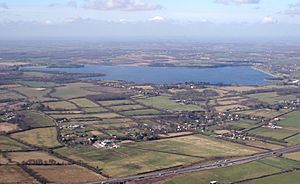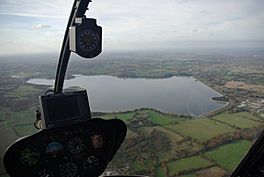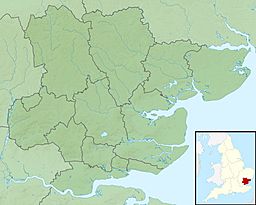Hanningfield Reservoir facts for kids
| Site of Special Scientific Interest | |
 |
|
| Area of Search | Essex |
|---|---|
| Interest | Biological |
| Area | 402.9 ha (996 acres) |
| Notification | 1985 |
| Location map | Magic Map |
| Hanningfield Reservoir | |
|---|---|
 |
|
| Location | Essex |
| Coordinates | 51°39′30″N 0°30′15″E / 51.65833°N 0.50417°E |
| Type | reservoir |
| Basin countries | United Kingdom |
| Max. width | 3.25 km (2.02 mi) |
| Average depth | 7.62 m (25.0 ft) |
| Max. depth | 16.76 m (55.0 ft) |
| Shore length1 | 6 mi (9.7 km) |
| Surface elevation | 55 m (180 ft) |
| 1 Shore length is not a well-defined measure. | |
Hanningfield Reservoir is a very large lake in Essex, England. It is located between the towns of Billericay and Chelmsford. This special place is known as a Site of Special Scientific Interest (SSSI). This means it is protected because of its important wildlife.
The reservoir is owned by Essex and Suffolk Water. They work with the Essex Wildlife Trust to look after it. It is also a special bird sanctuary, which means birds are protected here.
About Hanningfield Reservoir
Hanningfield Reservoir is the 11th largest reservoir in England. It covers a huge area of about 3.5 square kilometers (880 acres). The reservoir was built in 1957. Workers created it by flooding an area that used to be called Sandon Valley. A small, old village named Peasdown was also covered by the water.
Today, large parts of the reservoir and the land around it are a nature reserve. You can walk on many footpaths through the woodlands. These paths are great for spotting local wildlife. There are also special hides, which are like small shelters, where you can watch birds without disturbing them. Many different birds visit or live here.
If you enjoy fishing, you can go fly fishing at the reservoir during certain times of the year. You can fish from the bank or from a boat. Just remember to buy a fishing permit beforehand! The reservoir is regularly stocked with rainbow trout. The biggest fish ever caught here weighed over 10 kilograms (24 pounds) in 1998.
There are two cafes at Hanningfield Reservoir. One is near the fishing lodge and has a deck overlooking the water. The other cafe is at the Essex Wildlife Trust visitors' center.
Amazing Wildlife
Hanningfield Reservoir is home to many interesting animals and plants. It is especially important for birds. It has a nationally important population of gadwalls, which are a type of duck.
You can also see many other ducks here, including pochards, teal, tufted ducks, and pintails. These birds often visit the reservoir.
The reservoir also has some rare plants. In a muddy area called the chalk sludge lagoon, you might find unusual plants like golden dock and marsh dock. There is also a very rare moss called Brachythecium mildeanum growing at the bottom of the southern dam.


